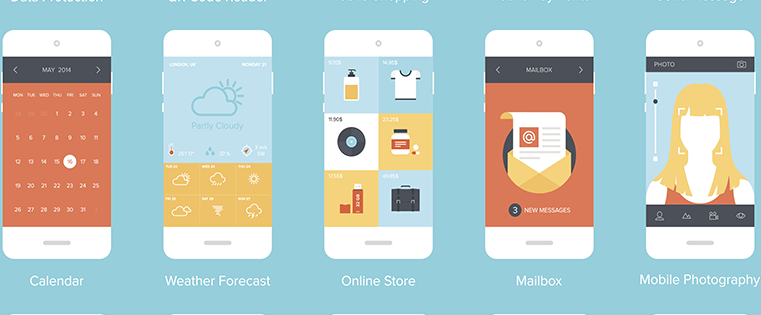 Inbound marketing is centered around being helpful. Instead of interrupting, tricking, or bombarding like the majority of traditional marketing avenues, inbound marketing focuses on integrating seamlessly into customers lives, and offering practical solutions.
Inbound marketing is centered around being helpful. Instead of interrupting, tricking, or bombarding like the majority of traditional marketing avenues, inbound marketing focuses on integrating seamlessly into customers lives, and offering practical solutions.
For most businesses, nearly 25% of the traffic coming to their website is from someone looking at it on a mobile device, according to Smart Insights. This means, as inbound marketers, we need to be helpful there, too.
There is a common misconception around optimizing for mobile readers, though. You actually don’t need a separate content strategy for mobile and desktop. You just need a great content strategy. And here’s how you can get it.
Questions You Need to Ask to Develop Your Mobile- and Desktop-Friendly Content Strategy
To be helpful on a phone, desktop or anything in between, your website needs to answer your visitor’s basic questions:
- How does your product/service help me? Your company improves people's lives in some way, otherwise you wouldn't still be in business. You must articulate this in a way that your visitors identify with.
- What can I do here? Users can likely do a number of things on your website, from downloading an ebook, to reading your blog, to asking to have a salesperson call. Make sure these capabilities are clear and prioritized. When the user isn't sure what to do next, you lose them.
- Why should I do it? You’re probably not the only available solution to your visitor's problems. Your visitors need to know why you are going to make their life better.
One additional question for mobile:
How quickly will you give me the answer? People need these questions answered quick on desktop, but even quicker on mobile. This is due to:
- Slower Load Time. If your site is taking too long to load, they will abandon it.
- Multitasking. If they are looking at your site on their phone, the odds are they are also watching TV, talking on the phone, or maybe even driving. (Yikes!)
- Harder to Navigate. No matter how clever your navigation is, it will be harder on a 4x6 mobile screen than it is on 21’ desktop monitor.
A Plan for Content With Mobile in Mind
Great content strategy is the key to answering these tough questions for your visitors. It doesn't matter how slick or hip your website is when your message doesn't resonate with readers. Building content that your visitors love is necessary for your website to fulfill its potential.
Doing this isn't simple, of course. Knowing your persona and how they want to communicate with your brand is an area that we must continually iterate and improve on. But there are some common areas that every website needs on mobile that are very attainable, and that you can start executing on immediately without overhauling your entire mobile and desktop content strategies.
The Four Virtues of Great Mobile Sites, That Also Apply to Desktop
- Concise. Never use 5 words when it takes 3. On a mobile screen those 2 extra words take up valuable inches. And wherever your reader's coming from, nobody likes needless reading.
- Definite Hierarchy of Needs. The most valuable information goes to the top. Always. Don’t expect your user to dig to find what they need. Make it easy for them.
- Better Navigation. Don’t waste the most valuable part of your page with your navigation. Find a nice little UX trick like garyvanderchuck.com or contentsmagazine.com to solve it. Once you do this, the navigation also needs to be simple and easy to follow. (Hint: The navigation also needs to be good for fat thumbs).
- Clear Content. When you use industry jargon, you're killing your website. When you beat around the bush, you're killing your website. When you convolute things your visitor cares about with things your company cares about, you're killing your website. On desktop, or mobile.
Here’s the secret sauce -- these are all great practices for your desktop website, and your mobile website. Really, it's just good content strategy -- designing, writing, and publishing with the reader in mind. A trick I like to keep in mind is this: if you plan for mobile first, your desktop website can follow the same plan and have tons of room to breathe, a much nicer reader experience that results in a smooth, clean design.
And when you're looking for guidance on your mobile and desktop content strategy, remember that inbound marketing teaches one thing: The one that is the most helpful wins.
This is a guest post by Jason Kosarek, Digital Strategist at LyntonWeb, a gold level HubSpot agency partner. He is also the author of a new ebook How To Plan a Website That Works.
Image credit: yoppy



![10 Best Mobile Friendliness Tests [+ What Does it Mean to be Mobile Friendly?]](https://www.hubspot.com/hubfs/mobile-friendliness-test.jpg)



![The Marketer's Guide to Mobile [Free Kit]](http://53.fs1.hubspotusercontent-na1.net/hubfs/53/Mobile%20Marketing%20Guide.jpg)
![How & When People Use Their Favorite Devices [Infographic]](http://53.fs1.hubspotusercontent-na1.net/hubfs/53/multiple-screens.jpeg)
![How Internet Behavior is Changing Around the World [Infographic]](http://53.fs1.hubspotusercontent-na1.net/hubfs/53/internet-behavior-shifts.jpeg)
![The State of the Mobile Experience: How People Use Their Phones Today [Infographic]](http://53.fs1.hubspotusercontent-na1.net/hubfs/53/00-Blog_Thinkstock_Images/Mobile_Experience.jpeg)
